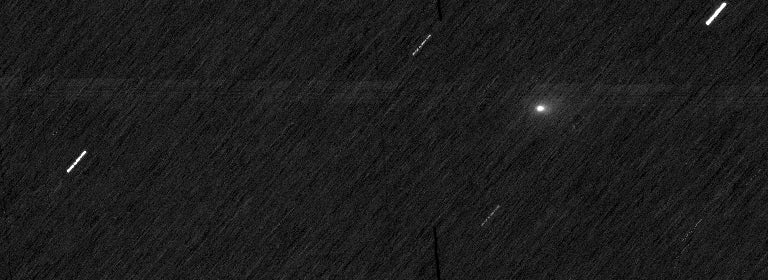When Comet 3I/ATLAS roared into the solar system this summer, it launched a scientific scramble to study what astronomers were quickly able to determine was only the third known interstellar object to zip through our celestial neighborhood.
And that science quickly went interplanetary. In early October, just three months after astronomers first spotted Comet 3I/ATLAS, NASA and European Space Agency (ESA) spacecraft operating at Mars turned their gaze on the interloper. In the coming days and weeks, Jupiter-bound missions will follow suit.
It’s a quest spanning the inner solar system, all spurred by scientists’ enthusiasm for the rare detection of an interstellar object. “Each one of these has been special and precious, and everybody drops everything to look at them,” says Karen Meech, a planetary astronomer at the University of Hawaii. And in an era when scientists are not yet able to launch a specialized mission to catch these strange visitors, recruiting spacecraft that are already exploring the solar system to do the job is the next best thing. “You’ve got kind of a mission for free,” Meech says.
On supporting science journalism
If you’re enjoying this article, consider supporting our award-winning journalism by subscribing. By purchasing a subscription you are helping to ensure the future of impactful stories about the discoveries and ideas shaping our world today.
Meet Comet 3I/ATLAS
The very name of Comet 3I/ATLAS gives away the basics of its story. It is a comet and the third object to pass through our solar system that scientists were able to confirm had originated from another star. It was first detected on July 1 by the Asteroid Terrestrial-Impact Last Alert System (ATLAS) survey telescope in Rio Hurtado, Chile.
Astronomers quickly determined that Comet 3I/ATLAS was zipping through space at an incredible 137,000 miles per hour and that its trajectory sketched a hyperbola rather than an ellipse—both signals that it came from beyond our solar system. As the third known interstellar object, 3I/ATLAS joins the ranks of 1I/‘Oumuamua, discovered in 2017, and Comet 2I/Borisov, discovered in 2019.
“Now we have three interstellar visitors,” says Quanzhi Ye, a planetary astronomer at the University of Maryland and Boston University. “And it looks like each of them has a different story to tell.”
Scientists working to understand these rare objects compare them to each other and to the 4,000-odd more mundane comets that have spent their entire existence in our own solar system. Sometimes the interstellar comets look familiar; sometimes they don’t. Scientifically, it’s a win-win situation. “Seeing differences from normal comets in our solar system is really interesting,” Meech says. “Seeing that they pretty much are all the same is interesting, too, because this gives us confidence that the process of building planets is the same everywhere.”
Ever since the discovery of Comet 3I/ATLAS, astronomers have been hard at work trying to glimpse clues to the object’s story. Within a few weeks, scientists also got a good enough image of the object to confirm it is a comet, an icy body whose material the sun’s heat turns into a vapor cloud, creating a fuzzy halo that scientists call a coma.
Subsequent observations have shown that coma is full of carbon dioxide. It’s an intriguing finding because frozen carbon dioxide, which we know as dry ice, turns to gas at quite cold temperatures. Seeing such substantial amounts of carbon dioxide on 3I/ATLAS means the object must have formed somewhere frigid and therefore quite far from its star, says Darryl Seligman, a planetary scientist at Michigan State University.
“That’s telling you, potentially, that comet formation is very different in other solar systems and that these interstellar comets are a totally different type of comet than those in the solar system,” he says.
The Best Time to Observe Is All the Time
When astronomers first glimpsed 3I/ATLAS in early July, the object was more than 400 million miles away from the sun, just within the orbit of Jupiter. But for interstellar objects, life moves pretty fast. On October 29, as it reached perihelion—the point in its trajectory when it was closest to the sun—it was more than 125 million miles away from our star, nearly half again as far as Earth’s orbital distance.
“Comets are dynamic little worlds because the sheer distance between them and the sun is always changing,” Seligman says. For interstellar comets, that’s even more true. “It’s like … everything is on the autobahn or something,” he says of these zippy objects.
A Hubble Space telescope image of the interstellar Comet 3I/ATLAS taken on July 21, 2025, when the comet was 226 million miles away from Earth.
NASA, ESA, D. Jewitt (UCLA); Image Processing: J. DePasquale (STScI)
A mainstay of comet science is to observe the brightness of an object as its distance from the sun changes because this causes the comet’s temperature to change. As the comet warms, new flavors of ice can turn to gas, causing sudden increases in brightness or outbursts.
“One of the most exciting parts of comet science is that you don’t know what it’s going to do in the next day or the next week,” Ye says.
By monitoring the comet’s brightness as it approaches the sun, scientists can infer what types of ice the comet holds. Subtleties of the process can offer even more detailed insight. For example, all that frozen carbon dioxide on 3I/ATLAS doesn’t appear to have begun turning to gas as soon as scientists expected, Meech says—suggesting that the dry ice was buried under the comet’s surface, potentially by previous swings past a star.
Perihelion brings any comet its starkest temperature changes, making the days surrounding this event some of the most intriguing to observe such a cosmic snowball. “Observations right near perihelion, when it’s warmest and has the most sunshine, is the most bang for your buck,” Seligman says. But for 3I/ATLAS, there’s just one problem: it is currently on the other side of the sun, where Earth-bound instruments cannot see it.
Spacecraft Ahoy
But humanity’s eyes in the solar system are no longer stuck on Earth, offering scientists a tantalizing opportunity to keep sight of 3I/ATLAS. “If you can get information from the target at a time when nothing on the ground can do it because it’s behind the sun, then you’ve got new information that you couldn’t get any other way,” Meech says.
That’s why, in the wake of the discovery of 3I/ATLAS, scientists hustled to coordinate an interplanetary observation campaign. NASA stated that a host of planetary science missions would attempt to observe Comet 3I/ATLAS: The Perseverance and Curiosity Mars rovers, the Mars Reconnaissance Orbiter, the Europa Clipper mission bound for Jupiter’s icy moon and the Lucy and Psyche asteroid missions. Also taking part are solar missions, including the Parker Solar Probe, the recently launched Polarimeter to Unify the Corona and Heliosphere (PUNCH) mission and the Solar and Heliospheric Observatory (SOHO), which NASA runs with ESA. And ESA missions that are at Mars or bound for Jupiter are doing so as well.
Despite scientists’ enthusiasm, catching an interstellar comet with an interplanetary spacecraft is not an easy feat. “On these space missions, each individual instrument is a feat of engineering meant for sampling and taking measurements when you’re really close to something,” Seligman says. Co-opting these finely tuned instruments to do something entirely beyond their brief is a bold move. “It’s like driving to work in a Lamborghini or something,” he says.
But there’s nothing mission scientists like more than a challenge—and so, in early October, as Comet 3I/ATLAS made its closest approach to Mars, spacecraft were ready. ESA has already shared images captured by its ExoMars orbiter, showing the comet zipping across its view some 19 million miles away. ESA scientists are still trying to find signs of the comet in data from its Mars Express orbiter.

ESA’s ExoMars Trace Gas Orbiter (TGO) spacecraft observed interstellar Comet 3I/ATLAS on October 3, 2025, from a distance of about 19 million miles away. The image stacks several exposures, making stars appear as streaks of light.
NASA, meanwhile, has gone silent. Just days before 3I/ATLAS made its closest approach to Mars, the federal government ran out of funding, and NASA, like all agencies, shut down any work that was not deemed mission critical. Typically, that designation includes tasks needed to keep operating missions healthy, such as basic communications and troubleshooting, but not image analysis and distribution.
Despite the U.S.’s federal shutdown, scientists do have direct access to some of the data that missions gather, and early hints suggest that the rush to study Comet 3I/ATLAS is paying off. On October 28 researchers posted a preprint paper based on data gathered as recently as four days prior from spacecraft that included the Earth-observing weather satellite GOES-19 and the sun-observing spacecraft SOHO and STEREO-A. These data suggest that the comet has brightened sharply in September and October, the scientists argued—a tantalizing possibility.
Now a new batch of spacecraft observations is beginning. On November 2 ESA’s Jupiter Icy Moons Explorer (JUICE) mission will turn its gaze on 3I/ATLAS, with observations continuing throughout the month to follow the comet as it cools after its swing by the sun.
A Most Tantalizing Opportunity
But NASA’s Europa Clipper spacecraft—a similar mission tailored to crack the mysteries of Jupiter’s iciest and most tantalizing moon—faces perhaps the most stunning opportunity of all. That’s because, according to a recent preprint, scientists have determined that between October 30 and November 6, the probe may fly directly through the ion tail of Comet 3I/ATLAS.
What exactly will come of the alignment is unclear, given the continuing government shutdown, and we certainly won’t know what, if any, observations Europa Clipper was able to make until the standoff ends and NASA resumes normal communications. But hopes are high that the mission team was able to arrange for observations in the case that it does catch the comet’s ion tail.
During a comet’s dash past our star, it can form two different tails. The dust tail always follows the comet’s body and includes uncharged material that is shed by the object, whereas the ion tail always points away from the sun because it is formed as charged particles streaming off the sun in the solar wind interact with gas surrounding the comet.
That makes the ion tail of an interstellar comet a roiling region, the product of ices from an alien star system meeting our sun’s grasping influence. Scientists don’t know exactly what Europa Clipper can learn if it indeed catches 3I/ATLAS’s ion tail because they’ve never made such observations before.
“Without previous examples of encounters with interstellar comets, it’s hard to say what we will get out of it,” wrote Sam Grant, an astrophysicist at the Finnish Meteorological Institute and a co-author of the preprint paper that identified the Europa Clipper opportunity, in an e-mail to Scientific American.
But to scientists, any attempt to catch an interstellar comet is worth harnessing. “You have a piece of another star system that’s close enough to home that we can actually study it in detail,” Meech says.
Additional reporting by Lee Billings.

